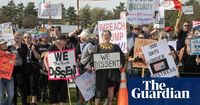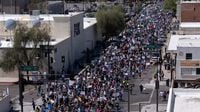On May 1, 2025, people across Asia and the United States took to the streets to mark May Day, also known as International Workers’ Day, with a series of marches and protests highlighting widespread discontent with U.S. President Donald Trump’s policies amidst fears of global economic instability. From Tokyo to Taipei to Manila, demonstrators voiced their concerns, reflecting a growing unease over the impact of Trump’s administration on workers and immigrant rights.
In the U.S., rallies were planned in major cities including Chicago, Los Angeles, New York, and Philadelphia. Organizers anticipated that tens of thousands would participate in what they described as a critical fight for workers’ rights and dignity. This year’s theme focused on the struggle against Trump’s approach to immigration, federal employment, and diversity initiatives, which many believe threaten the fabric of the labor movement.
In Taiwan, President William Lai Ching-te addressed the issue of new U.S. tariffs under Trump while promoting a proposed spending bill aimed at stabilizing the job market. Meanwhile, in the Philippines, protest leader Mong Palatino warned that “tariff wars and policies of Trump” posed significant threats to local industries.
The atmosphere in Japan was equally charged. Participants in Tokyo’s May Day march raised demands for higher wages, gender equality, healthcare, disaster relief, and a ceasefire in Gaza, as well as an end to Russia’s invasion of Ukraine. “For our children to be able to live with hope, the rights of workers must be recognized,” said Junko Kuramochi, a member of a mothers’ group.
Los Angeles was set to host one of the largest May Day events globally, with banners proclaiming solidarity among workers. April Verrett, president of the Service Employees International Union, which represents 2 million workers, emphasized that “an attack on immigrant workers is an attack on all workers.” Her statement underscored the interconnectedness of the labor movement across various demographics.
Nationwide, the protests were supported by hundreds of organizations and were expected to occur in nearly 1,000 cities. Despite the weekday timing potentially reducing turnout, enthusiasm remained high following two significant protest days in April: the “Hands Off” rallies on April 5 and the “Day of Action” on April 19, which drew millions to the streets.
The May Day protests were not just about labor rights; they also highlighted a broader backlash against Trump’s administration and its billionaire supporters. Organizers accused Trump and figures like Elon Musk of attempting to “erase labor rights, break our unions, and silence immigrant voices.” The rhetoric surrounding the protests framed them as a response to what many see as a systematic war on working people.
In Philadelphia, Senator Bernie Sanders was scheduled to join the “Workers over Billionaires” rally, a clear indication of the political weight behind the protests. This event was part of a larger movement that has gained momentum since Trump’s controversial election, with his approval ratings plummeting as more Americans disapprove of his policies.
Jorge Mújica, the strategic organizer for Arise Chicago, commented on the administration’s miscalculations. He noted, “The Trump administration miscalculated completely by targeting so many constituencies in its first 100 days.” This miscalculation has led to a broad coalition of labor unions, federal workers, students, and educators uniting for the May Day events.
As the protests unfolded, they also served as a reminder of May Day’s historical significance. The origins of May Day date back to 1886 when laborers in Chicago rallied for an eight-hour workday, an event that ultimately led to violent clashes and the establishment of International Workers’ Day. Today, May Day is recognized in many countries around the world, but in the U.S., efforts to shift Labor Day from September to May have not succeeded.
In addition to the domestic protests, organizers announced that demonstrations would also take place abroad, including in cities like Florence, Italy, and Paris, as part of a global movement advocating for workers’ rights. The events were branded as “May Day 2025” and “May Day Strong,” utilizing the hashtag #MayDayStrong to galvanize support.
Reflecting on the significance of the day, the organizers’ website stated, “We are reclaiming our power from corporate elites, and we will not be intimidated by Trump, Musk, or their billionaire backers. They’ve ruled for too long. Their time is up. And May Day is just the beginning.”
As the day unfolded, the protests served not only as a platform for workers to voice their concerns but also as a critical moment of solidarity among various groups fighting for justice and equality. The collective action demonstrated that the movement against Trump’s policies is not just about labor rights but encompasses a wider struggle for dignity, respect, and basic human rights for all.





